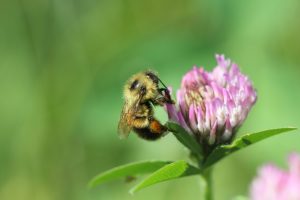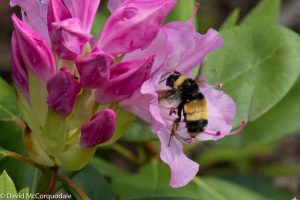What’s all the Buzz about?
Bumble bees are charismatic creatures that play an important role in our everyday lives. When they are buzzing around and foraging for food, bumble bees pollinate a variety of plants. Pollination kick starts the growth of the fruit and vegetables that we eat and is required for many species to produce seeds that become new plants. Other insects, birds, and mammals also rely on bumble bee pollination to produce their food. Bumble bees are a critical part of the earth’s ecosystems and this online Guide to Bumblebees in Cape Breton will show you just how special these small and mighty creatures are.

Bumble bee behaviour has a huge impact on terrestrial ecosystems. Dwindling bumblebee populations can cause a chain reaction through the ecosystems. This can result in lower biodiversity which can make an ecosystem less resilient to change. In a way, when bumble bees are at risk, the entire ecosystem also becomes at risk.
Over the years, human disturbances have had a negative effect on bumble bees in more ways than one. Pesticide use, industrial agriculture, the introduction of non-native species such as honey bees, housing subdivisions, shopping malls, and other commercial and residential land uses have put vulnerable bumble bee populations at risk. Despite these challenges, some species of bumble bees are thriving in these new environments as they have been able to adapt to changing environmental conditions.
In order to protect the bumble bees of Unama’ki (Cape Breton), we need your help! In the next few chapters, you will learn about bumble bee anatomy, life cycles, and the role each bee plays in a colony.

The transport of pollen from one plant to another is a major part of a plant's life cycle. While foraging, pollen brushes onto bumble bees and as they fly from flower to flower of the same species, they fertilize the plants as they go. Plants that are pollinated can produce seeds which means more plants will grow. For more information visit The Eden Project.
A geographic area where plants, animals, and other organisms, as well as weather and landscapes, work together to form a bubble of life (Source: National Geographic. Visit Site)
A habitat that is made up of a variety of different species which means that it is healthy and resilient to environmental disturbances such as climate change. Human disturbances can have a negative impact on biodiversity.
An action caused by humans that can have negative consequences on the environment and the organisms that live there. This is usually unnatural and would not happen without the presence of humans.
A harmful substance that kills living things such as plants, insects, or fungi. These chemicals are often used in industrial agriculture practices.
Large scale farming practices that are often harmful to the environment due to pesticide use and the use of heavy machinery that run on fossil fuels. These practices, require a large amount of water, lower biodiversity, and can deplete soil nutrients.
A species that has been introduced to an area that is not within its natural range by humans. Can also be referred to as an invasive species in some circumstances.
Apis mellifera. A non native species of bee that was introduced to Canada by humans. These bees are used in commercial settings and they are farmed for their honey production.

